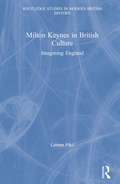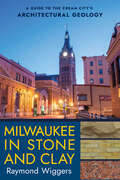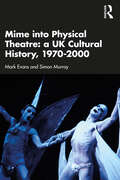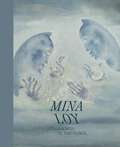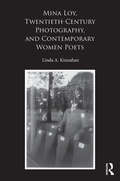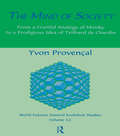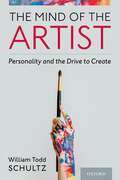- Table View
- List View
Milton Keynes in British Culture: Imagining England (Routledge Studies in Modern British History)
by Lauren PikóThe new town of Milton Keynes was designated in 1967 with a bold, flexible social vision to impose "no fixed conception of how people ought to live." Despite this progressive social vision, and its low density, flexible, green urban design, the town has been consistently represented in British media, political rhetoric and popular culture negatively. as a fundamentally sterile, paternalistic, concrete imposition on the landscape, as a "joke", and even as "Los Angeles in Buckinghamshire". How did these meanings develop at such odds from residents' and planners' experiences? Why have these meanings proved so resilient? Milton Keynes in British Culture traces the representations of Milton Keynes in British national media, political rhetoric and popular culture in detail from 1967 to 1992, demonstrating how the town's founding principles came to be understood as symbolic of the worst excesses of a postwar state planning system which was falling from favour. Combining approaches from urban planning history, cultural history and cultural studies, political economy and heritage studies, the book maps the ways in which Milton Keynes' newness formed an existential challenge to ideals of English landscapes as receptacles of tradition and closed, fixed national identities. Far from being a marginal, "foreign" and atypical town, the book demonstrates how the changing political fortunes of state urban planned spaces were a key site of conflict around ideas of how the British state should function, how its landscapes should look, and who they should be for.
Milton's Vision: The Birth of Christian Liberty
by Theo HobsonNo other writer is so grudgingly admired as Milton. He wrote great poetry, goes the received wisdom, but his creed was narrow, chilling, and inhuman. His reputation is that of a stereotypical Puritan and authoritarian. Yet Theo Hobson maintains that no one opposed religious authoritarianism with such vehemence. Indeed, he argues that no one was so adamant that political freedom is built into the Christian gospel. Milton insisted that Protestantism was compatible with political liberty-that the two ideas are complementary. By treating all ecclesiastical authority with suspicion, he helped to establish the modern ideal of secularism. He was a Christian libertarian who wanted every form of church to wither away, so that the Gospel might be completely free of coercion. Milton's Vision is thus a vital contribution to the contemporary debate about the place of religion in public life. There has never been a study of Milton that highlights his relevance to the core issues of our day: how religion gives rise to and interacts with secular ideals.
Milwaukee in Stone and Clay: A Guide to the Cream City's Architectural Geology
by Raymond WiggersMilwaukee in Stone and Clay follows directly in the footsteps of Raymond Wiggers's previous award-winning book, Chicago in Stone and Clay. It offers a wide-ranging look at the fascinating geology found in the building materials of Milwaukee County's architectural landmarks. And it reveals the intriguing and often surprising links between science, art, and engineering. Laid out in two main sections, the book first introduces the reader to the fundamentals of Milwaukee's geology and its amazing prehuman history, then provides a site-by-site tour guide. Written in an engaging, informal style, this work presents the first in-depth exploration of the interplay among the region's most architecturally significant sites, the materials they're made of, and the sediments and bedrock they're anchored in. Raymond Wiggers crafted Milwaukee in Stone and Clay as an informative and exciting overview of this city. His two decades of experience leading architectural-geology tours have demonstrated the popularity of this approach and the subject matter.
Mime into Physical Theatre: A UK Cultural History 1970–2000
by Mark Evans Simon MurrayThis is the first book to investigate the social, political, cultural, artistic and economic forces which created conditions for the rise, success and decline of mime and physical theatre in the United Kingdom, from the 1970s to 2000. Unpicking the various routes through which mime and physical theatre emerged into wider prominence, this book outlines key thematic strands within this history of practice. The book blends historical description and refl ective analysis. It aims to juxtapose the various histories at play within this field, giving critical attention to the voices of the artists, funders and venue managers who were there at the time, particularly recognising the diversity of practitioners and the network of relationships that supported their work. Drawing upon over 40 original interviews, including, amongst others: Joseph Seelig, Helen Lannaghan, Steven Berkoff, Julian Chagrin, Annabel Arden, Nola Rae, Denise Wong, David Glass, Justin Case and Toby Sedgwick, the book offers unique testimonies and memories from key figures active during these three decades. This wide-ranging account of the history, social context, key moments and practical methods gives an unparalleled chronicle of one of the UK’s most vital and pioneering forms of theatre. From undergraduate students to established scholars, this is a comprehensive account for anyone studying contemporary theatre, theatre history, mime, physical theatre and the structures that support the performing arts in the United Kingdom.
Mime into Physical Theatre: A UK Cultural History 1970–2000
by Mark Evans Simon MurrayThis is the first book to investigate the social, political, cultural, artistic and economic forces which created conditions for the rise, success and decline of mime and physical theatre in the United Kingdom, from the 1970s to 2000. Unpicking the various routes through which mime and physical theatre emerged into wider prominence, this book outlines key thematic strands within this history of practice. The book blends historical description and refl ective analysis. It aims to juxtapose the various histories at play within this field, giving critical attention to the voices of the artists, funders and venue managers who were there at the time, particularly recognising the diversity of practitioners and the network of relationships that supported their work. Drawing upon over 40 original interviews, including, amongst others: Joseph Seelig, Helen Lannaghan, Steven Berkoff, Julian Chagrin, Annabel Arden, Nola Rae, Denise Wong, David Glass, Justin Case and Toby Sedgwick, the book offers unique testimonies and memories from key figures active during these three decades. This wide-ranging account of the history, social context, key moments and practical methods gives an unparalleled chronicle of one of the UK’s most vital and pioneering forms of theatre. From undergraduate students to established scholars, this is a comprehensive account for anyone studying contemporary theatre, theatre history, mime, physical theatre and the structures that support the performing arts in the United Kingdom.
Mimesis und moderne Architektur: Eine architekturtheoretische Neubewertung (Architekturen #42)
by Hartmut MayerMimesis in der Architektur ist Nachahmung von Natur und Welt auf vorbewusste, ontologische Weise - und sie ist grundlegend für das Verständnis der vormodernen wie der modernen Architektur. Im Diskurs mit der philosophischen Ästhetik seit der Antike verdeutlicht Hartmut Mayer die fundamentale Bedeutung der Mimesis für die Architekturtheorie. Im Rückgriff auf Nietzsche und Adorno interpretiert er Mimesis im 20. und 21. Jahrhundert als Permanenz der querelle des anciens et des modernes und einer »Verleiblichung« ästhetischer Prinzipien.
Mimetic Theory and Film (Violence, Desire, and the Sacred #8)
by Chris Fleming Paolo Diego BubbioThe interdisciplinary French-American thinker René Girard (1923-2015) has been one of the towering figures of the humanities in the last half-century. The title of René Girard's first book offered his own thesis in summary form: romantic lie and novelistic truth [mensonge romantique et vérité romanesque]. And yet, for a thinker whose career began by an engagement with literature, it came as a shock to some that, in La Conversion de l'art, Girard asserted that the novel may be an “outmoded” form for revealing humans to themselves. However, Girard never specified what, if anything, might take the place of the novel. This collection of essays is one attempt at answering this question, by offering a series of analyses of films that aims to test mimetic theory in an area in which relatively little has so far been offered. Does it make any sense to talk of vérité filmique? In addition, Mimetic Theory and Film is a response to the widespread objection that there is no viable “Girardian aesthetics.” One of the main questions that this collection considers is: can we develop a genre-specific mimetic analysis (of film), and are we able to develop anything approaching a “Girardian aesthetic”? Each of the contributors addresses these questions through the analysis of a film.
Mimetic Theory and Film (Violence, Desire, and the Sacred #8)
by Chris Fleming Paolo Diego BubbioThe interdisciplinary French-American thinker René Girard (1923-2015) has been one of the towering figures of the humanities in the last half-century. The title of René Girard's first book offered his own thesis in summary form: romantic lie and novelistic truth [mensonge romantique et vérité romanesque]. And yet, for a thinker whose career began by an engagement with literature, it came as a shock to some that, in La Conversion de l'art, Girard asserted that the novel may be an “outmoded” form for revealing humans to themselves. However, Girard never specified what, if anything, might take the place of the novel. This collection of essays is one attempt at answering this question, by offering a series of analyses of films that aims to test mimetic theory in an area in which relatively little has so far been offered. Does it make any sense to talk of vérité filmique? In addition, Mimetic Theory and Film is a response to the widespread objection that there is no viable “Girardian aesthetics.” One of the main questions that this collection considers is: can we develop a genre-specific mimetic analysis (of film), and are we able to develop anything approaching a “Girardian aesthetic”? Each of the contributors addresses these questions through the analysis of a film.
Mina Loy: Strangeness Is Inevitable
by Jennifer R. Gross Ann Lauterbach Roger L. Conover Dawn AdesA richly illustrated exploration of Mina Loy’s art and writingsMina Loy (1882–1966) was one of the most iconoclastic figures in modernism. A groundbreaking poet, she also left an indelible mark in painting, drawing, prose, art criticism, and fashion. Mina Loy: Strangeness Is Inevitable is the first book to examine the full scope of her extraordinary career, demonstrating Loy’s transformative impact on the visual arts as well as the literary avant-garde of the twentieth century.Presenting dozens of Loy’s paintings, drawings, and constructions alongside selections of her poems and writings, this book gives a comprehensive overview of the complex images and objects Loy created and situates them in the larger context of her life and work. It explores Loy’s pursuit of truth and beauty, arguing that her engagement with the emphatically “unbeautiful” materials of the Bowery—such as rags and bottle caps—reflects her questioning of truth. The book positions Loy within the broader context of surrealist art; sheds light on her relationships with influential figures such as Gertrude Stein, Marcel Duchamp, and Wyndham Lewis; and addresses Loy’s enduring relevance today.Featuring rare and previously unpublished artworks, Mina Loy: Strangeness Is Inevitable reveals this visionary artist’s extraordinary contributions as an image-maker, writer, and cultural arbiter, introducing her work to a new generation of readers and charting new directions in art history, women’s studies, poetry, and modernist studies.Published in association with the Bowdoin College Museum of ArtExhibition ScheduleBowdoin College Museum of Art, Brunswick, MaineApril 6–September 17, 2023
Mina Loy, Twentieth-Century Photography, and Contemporary Women Poets
by Linda A. KinnahanIn Mina Loy, Twentieth-Century Photography, and Contemporary Women Poets, Linda A. Kinnahan explores the making of Mina Loy’s late modernist poetics in relation to photography’s ascendance, by the mid-twentieth century, as a distinctively modern force shaping representation and perception. As photography develops over the course of the century as an art form, social tool, and cultural force, Loy’s relationship to a range of photographic cultures emerging in the first half of the twentieth century suggests how we might understand not only the intriguing work of this poet, but also the shaping impact of photography and new technologies of vision upon modernist poetics. Framing Loy’s encounters with photography through intersections of portraiture, Surrealism, fashion, documentary, and photojournalism, Kinnahan draws correspondences between Loy’s late poetry and visual discourses of the body, urban poverty, and war, discerning how a visual rhetoric of gender often underlies these mappings and connections. In her final chapter, Kinnahan examines two contemporary poets who directly engage the camera’s modern impact –Kathleen Fraser and Caroline Bergvall – to explore the questions posed in their work about the particular relation of the camera, the photographic image, and the construction of gender in the late twentieth century.
Mina Loy, Twentieth-Century Photography, and Contemporary Women Poets
by Linda A. KinnahanIn Mina Loy, Twentieth-Century Photography, and Contemporary Women Poets, Linda A. Kinnahan explores the making of Mina Loy’s late modernist poetics in relation to photography’s ascendance, by the mid-twentieth century, as a distinctively modern force shaping representation and perception. As photography develops over the course of the century as an art form, social tool, and cultural force, Loy’s relationship to a range of photographic cultures emerging in the first half of the twentieth century suggests how we might understand not only the intriguing work of this poet, but also the shaping impact of photography and new technologies of vision upon modernist poetics. Framing Loy’s encounters with photography through intersections of portraiture, Surrealism, fashion, documentary, and photojournalism, Kinnahan draws correspondences between Loy’s late poetry and visual discourses of the body, urban poverty, and war, discerning how a visual rhetoric of gender often underlies these mappings and connections. In her final chapter, Kinnahan examines two contemporary poets who directly engage the camera’s modern impact –Kathleen Fraser and Caroline Bergvall – to explore the questions posed in their work about the particular relation of the camera, the photographic image, and the construction of gender in the late twentieth century.
Mind and Art: An Essay on the Varieties of Expression
by Guy SircelloGuy Sircello's analysis of the varieties of expression and his use of them to justify a particular view of the human mind clarify a number of controversial topics in contemporary philosophy, among them the notion of "artistic acts," language as expression, the expression of ideas, expressions as "natural signs," and the nature of the causal relationship between an expression and what is expressed.Originally published in 1972.The Princeton Legacy Library uses the latest print-on-demand technology to again make available previously out-of-print books from the distinguished backlist of Princeton University Press. These editions preserve the original texts of these important books while presenting them in durable paperback and hardcover editions. The goal of the Princeton Legacy Library is to vastly increase access to the rich scholarly heritage found in the thousands of books published by Princeton University Press since its founding in 1905.
The Mind-Body Stage: Passion and Interaction in the Cartesian Theater
by R. Darren GobertDescartes's notion of subjectivity changed the way characters would be written, performed by actors, and received by audiences. His coordinate system reshaped how theatrical space would be conceived and built. His theory of the passions revolutionized our understanding of the emotional exchange between spectacle and spectators. Yet theater scholars have not seen Descartes's transformational impact on theater history. Nor have philosophers looked to this history to understand his reception and impact. After Descartes, playwrights put Cartesian characters on the stage and thematized their rational workings. Actors adapted their performances to account for new models of subjectivity and physiology. Critics theorized the theater's emotional and ethical benefits in Cartesian terms. Architects fostered these benefits by altering their designs. The Mind-Body Stage provides a dazzlingly original picture of one of the most consequential and confusing periods in the histories of modern theater and philosophy. Interdisciplinary and comparatist in scope, it uses methodological techniques from literary study, philosophy, theater history, and performance studies and draws on scores of documents (including letters, libretti, religious jeremiads, aesthetic treatises, and architectural plans) from several countries.
The Mind-Game Film: Distributed Agency, Time Travel, and Productive Pathology
by Thomas ElsaesserThis book represents the culmination of Thomas Elsaesser’s intense and passionate thinking about the Hollywood mind-game film from the previous two decades. In order to answer what the mind-game film is, why they exist, and how they function, Elsaesser maps the industrial-institutional challenges and constraints facing Hollywood, and the broader philosophic horizon within which American cinema thrives today. He demonstrates how the ‘Persistence of Hollywood’ continues as it has adapted to include new twists and turns, as well as revisions of past concerns, as film moves through the 21st century. Through examples such as Minority Report, Mulholland Drive, Source Code, and Back to the Future, Elsaesser explores how mind-game films challenge us and play games with our perception of reality, creating skepticism and (self-) doubt. He also highlights the mind-game film's tendency to intervene in a complex fashion in the political moment by questioning the dominant power’s intent to program both body and mind alike. Prescient and compelling, The Mind-Game Film will appeal to students, scholars, and enthusiasts of media studies, film studies, philosophy, and politics.
The Mind-Game Film: Distributed Agency, Time Travel, and Productive Pathology
by Thomas ElsaesserThis book represents the culmination of Thomas Elsaesser’s intense and passionate thinking about the Hollywood mind-game film from the previous two decades. In order to answer what the mind-game film is, why they exist, and how they function, Elsaesser maps the industrial-institutional challenges and constraints facing Hollywood, and the broader philosophic horizon within which American cinema thrives today. He demonstrates how the ‘Persistence of Hollywood’ continues as it has adapted to include new twists and turns, as well as revisions of past concerns, as film moves through the 21st century. Through examples such as Minority Report, Mulholland Drive, Source Code, and Back to the Future, Elsaesser explores how mind-game films challenge us and play games with our perception of reality, creating skepticism and (self-) doubt. He also highlights the mind-game film's tendency to intervene in a complex fashion in the political moment by questioning the dominant power’s intent to program both body and mind alike. Prescient and compelling, The Mind-Game Film will appeal to students, scholars, and enthusiasts of media studies, film studies, philosophy, and politics.
Mind Games: Über literarische, psychoanalytische und gendertheoretische Sendeinhalte bei A.C.Doyle und der BBC-Serie Sherlock
by Andreas JackeDas Buch analysiert die Hintergründe der BBC-TV-Serie Sherlock und versucht dabei verschiedene Themengebiete abzustecken: Psychoanalytisch, gendertheoretisch, literaturwissenschaftlich und filmwissenschaftlich wird der Versuch unternommen, den ungeheuren Reiz dieses einzigartigen und sehr populären Updates zu analysieren.Ausgehend von den strukturellen Vorgaben von Doyles’ Geschichten wird so der Weg ihrer Umschreibung zum Comedy-Thriller für das TV im 21. Jahrhundert sichtbar. Dabei bekam der eigenwillige Detektiv nun nicht nur einen stärkeren Watson zur Seite gestellt, auch seine latente Frauenfeindlichkeit und ihre Hintergründe wurden erstmals problematisiert.
Mind in Art: Cognitive Foundations in Art Education
by Charles M. DornThis book is for the reader who believes that thinking about and making art is intelligent behavior and that art as a subject in the K-12 school curriculum should not be used as an alibi for other curricular objectives. It examines and makes explicit those cognitive behaviors normally associated with most higher order thinking and problem solving activity and explains how they function in the act of creative forming. Its goal is ultimately to find ways to use these behaviors in the construction of an intelligent art curriculum for K-12 American schools. This is perhaps the only text in the field designed to assist teachers in meeting the challenges of teaching in the Goals 2000 curriculum and evaluation reform effort, acquainting them with both the National Art Standards and with the assessment processes needed in order for them to become accountable. Mind in Art grapples with current and relevant theory, research, and unsolved problems. It is cohesive as it attempts to bring together information that is only partially known, even among those who are college professors. And it takes a critical look at the ideas and points of view that have created divisiveness and shabby thinking in the field. In this book Charles Dorn significantly advances thinking in the field of art education.
Mind in Art: Cognitive Foundations in Art Education
by Charles M. DornThis book is for the reader who believes that thinking about and making art is intelligent behavior and that art as a subject in the K-12 school curriculum should not be used as an alibi for other curricular objectives. It examines and makes explicit those cognitive behaviors normally associated with most higher order thinking and problem solving activity and explains how they function in the act of creative forming. Its goal is ultimately to find ways to use these behaviors in the construction of an intelligent art curriculum for K-12 American schools. This is perhaps the only text in the field designed to assist teachers in meeting the challenges of teaching in the Goals 2000 curriculum and evaluation reform effort, acquainting them with both the National Art Standards and with the assessment processes needed in order for them to become accountable. Mind in Art grapples with current and relevant theory, research, and unsolved problems. It is cohesive as it attempts to bring together information that is only partially known, even among those who are college professors. And it takes a critical look at the ideas and points of view that have created divisiveness and shabby thinking in the field. In this book Charles Dorn significantly advances thinking in the field of art education.
Mind Museums: Former Asylums and the Heritage of Mental Health (Museums in Focus)
by Francesca LanzMind Museums offer a fresh perspective on the heritage of mental health,bringing museums into sharp focus. Drawing on interdisciplinary approachesfrom architecture, museum and exhibition design, and heritage and museumstudies, it examines former psychiatric asylums that have been converted intomuseums.The book presents a comprehensive investigation of mind museums, thefirst of its kind in Europe, and explores their potential in raising awarenessand dismantling the stigma surrounding mental health. Through an indepthexamination of selected European examples, Lanz describes whatmind museums are and how they came to be. The innovative visitor studiescarried out at the Museo di Storia della Psichiatria in Reggio Emilia, whichare presented here, explore people’s encounters with mind museums andreveal the profound impact of such experiences. By uncovering the power ofthese heritage sites in facilitating discussions on mental health, civility, andcare, Lanz provides new insights into the emotive capacity of the museumand visitors’ reflexivity at place-based memory sites.Mind Museums will be of great interest to scholars and postgraduatelevelstudents engaged in the study of museums, heritage, exhibitiondesign, architecture, and mental health. It should also be of interest toheritage professionals, particularly those working in mind museums andother similar sites, such as prison museums and sites of conscience.
Mind Museums: Former Asylums and the Heritage of Mental Health (Museums in Focus)
by Francesca LanzMind Museums offer a fresh perspective on the heritage of mental health,bringing museums into sharp focus. Drawing on interdisciplinary approachesfrom architecture, museum and exhibition design, and heritage and museumstudies, it examines former psychiatric asylums that have been converted intomuseums.The book presents a comprehensive investigation of mind museums, thefirst of its kind in Europe, and explores their potential in raising awarenessand dismantling the stigma surrounding mental health. Through an indepthexamination of selected European examples, Lanz describes whatmind museums are and how they came to be. The innovative visitor studiescarried out at the Museo di Storia della Psichiatria in Reggio Emilia, whichare presented here, explore people’s encounters with mind museums andreveal the profound impact of such experiences. By uncovering the power ofthese heritage sites in facilitating discussions on mental health, civility, andcare, Lanz provides new insights into the emotive capacity of the museumand visitors’ reflexivity at place-based memory sites.Mind Museums will be of great interest to scholars and postgraduatelevelstudents engaged in the study of museums, heritage, exhibitiondesign, architecture, and mental health. It should also be of interest toheritage professionals, particularly those working in mind museums andother similar sites, such as prison museums and sites of conscience.
The Mind of Leonardo da Vinci (Dover Fine Art, History Of Art Series)
by Edward McCurdyIn this classic, engrossing text, a distinguished historian explores the mind and manifold interests of the greatest personality of the Renaissance. More than just a biography, the book presents a detailed investigation of Leonardo's genius. Its colorful, evocative prose offers numerous demonstrations of the master's achievements, not only in sculpture and painting, but also in music, engineering, and even experimental aviation.A renowned authority on the works and personality of Leonardo, author Edward McCurdy translated many of the artist's writings. "In the thousands of pages of his manuscript he has left the mirror of his thought," McCurdy observes, "and there his mind may be seen at work, moving among the phenomena of nature and the inherited knowledge of antiquity, trying all things, expounding all things, proving all things." McCurdy begins by tracing the artist's travels, from his native Florence to Milan, Venice, Rome, and France. Part Two examines the manuscripts and their philosophical revelations, and the third section assesses the paintings and sculpture. First published in 1928, this book remains one of the best introductions to Leonardo and his extraordinary versatility.
Mind of Society
by ProvencalFirst Published in 1999. Routledge is an imprint of Taylor & Francis, an informa company.
Mind of Society
by ProvencalFirst Published in 1999. Routledge is an imprint of Taylor & Francis, an informa company.
The Mind of the Artist: Personality and the Drive to Create
by William Todd SchultzWhat is "the artist type"? How is an artist's mind structured? What are the links between creativity and mental health? Are there particular personality traits and psychological experiences that great artists have in common? Are most artists really mad? What defines the artist's personality? This book answers these questions by way of a deep, multi-angled, psychological analysis of the personality-based roots of creativity and the creative process. It draws on decades of scientific research focused on the central, mysterious trait of Openness, the true unifying glue behind everything creative. Featuring dozens of notable creators such as John Coltrane, Diane Arbus, Francesca Woodman, David Bowie, Frida Kahlo, Jack Kerouac, John Lennon, and others, this book showcases the nuances of an artist's mind beyond oversimplified formulas that falsely connect art to mental illness, painting a more authentic picture of the structure of the artist's psychology. Ultimately, this book reveals that the "torture" in an artist's perceived image has more to do with personality, creative processes, states of mind, and a need to express trauma symbolically, repeating it in the form of art. As an eminent psychobiographer with an award-winning career as a personality and creativity psychologist, Dr. William Todd Schultz yet again offers his unique perspective on a fascinating topic that is both engaging and insightful. In exploring the precise nature of inner chaos in a wide range of renowned artists, this book takes an enchanting dive into the artistic abyss for all those interested in creativity, personality, and psychology, including both general and academic readers.
The Mind of the Artist: Personality and the Drive to Create
by William Todd SchultzWhat is "the artist type"? How is an artist's mind structured? What are the links between creativity and mental health? Are there particular personality traits and psychological experiences that great artists have in common? Are most artists really mad? What defines the artist's personality? This book answers these questions by way of a deep, multi-angled, psychological analysis of the personality-based roots of creativity and the creative process. It draws on decades of scientific research focused on the central, mysterious trait of Openness, the true unifying glue behind everything creative. Featuring dozens of notable creators such as John Coltrane, Diane Arbus, Francesca Woodman, David Bowie, Frida Kahlo, Jack Kerouac, John Lennon, and others, this book showcases the nuances of an artist's mind beyond oversimplified formulas that falsely connect art to mental illness, painting a more authentic picture of the structure of the artist's psychology. Ultimately, this book reveals that the "torture" in an artist's perceived image has more to do with personality, creative processes, states of mind, and a need to express trauma symbolically, repeating it in the form of art. As an eminent psychobiographer with an award-winning career as a personality and creativity psychologist, Dr. William Todd Schultz yet again offers his unique perspective on a fascinating topic that is both engaging and insightful. In exploring the precise nature of inner chaos in a wide range of renowned artists, this book takes an enchanting dive into the artistic abyss for all those interested in creativity, personality, and psychology, including both general and academic readers.
